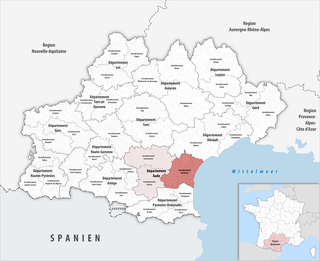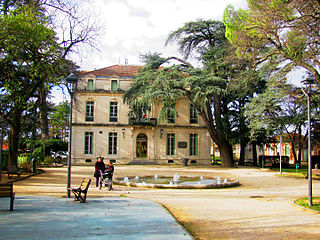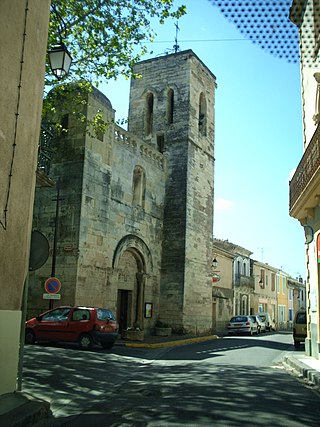
Aude is a department in Southern France, located in the Occitanie region and named after the river Aude. The departmental council also calls it "Cathar Country" after a group of religious dissidents active in the 12th to 14th centuries.

Fitou is a large French wine appellation in Languedoc-Roussillon, France. The dominant vine variety is Carignan which has to constitute 40% of any blend for that to qualify for the appellation. Grenache, Lladoner Pelut, Mourvèdre and Syrah are often blended with it. Muscat de Rivesaltes AOC, a vin doux naturel, also comes from the region.

The arrondissement of Narbonne is an arrondissement of France in the Aude department in the Occitanie région. Its INSEE code is 113 and its capital city is Narbonne. It has 109 communes. Its population is 165,940 (2016), and its area is 2,101.9 km2 (811.5 sq mi).

Villeneuve-les-Corbières is a commune in the Aude department in southern France.

Corbières is an Appellation d'origine contrôlée (AOC) for wine in the Languedoc-Roussillon, France, and it is this region's largest AOC, responsible for 46 per cent of the region's AOC wine production in 2005. Red wine dominates the production in Corbières with almost 95 per cent, with 3.5 per cent rosé wine and 2 per cent white wine making up the balance. Carignan is the most common grape variety. The AOC was created in 1985, covers 13,500 hectares of vineyards and produces an average of 554,000 hectoliters of wine per year, corresponding to 74 million bottles.

The Corbières Massif is a mountain range in the Pre-Pyrenees. It is the only true foothill of the Pyrenees on their northern side.

Aubord is a commune in the Gard department in southern France. Aubord is situated 15 km (9.3 mi) southwest of Nîmes.

Bouillargues is a commune in the Gard department in southern France. It includes the hamlets of Garons, Caissargues and Rodilhan. It is situated to the southeast and close to the city of Nimes and in 2013 it had just over 6,000 residents.

Le Cailar is a commune in the Gard department in southern France. It is located at the confluence of the River Vistre and the River Rhôny. It was an important port during the Iron Age at a time when lagoons connected to the Mediterranean Sea covered the adjoining low-lying land.

Lézignan-Corbières is a commune in the Aude department in the Occitanie region in southern France. Situated in the Corbières wine region not far from Narbonne, it has a Vine and Wine Museum.

Arquettes-en-Val is a commune in the Aude department in the Occitanie region of southern France.

Argens-Minervois is a commune in the Aude department in the Occitanie region of southern France.

Barbaira is a commune in the Aude department in the Occitanie region of southern France.
Cascastel-des-Corbières is a commune in the Aude department in southern France.

Fabrezan is a commune in the Aude department in southern France.

Ferrals-les-Corbières is a commune in the Aude department in southern France.

Gruissan is a commune in the Aude department in southern France. The historian Émile Raunié (1854–1911) was born in Gruissan.

Luc-sur-Orbieu is a commune in the Aude department in southern France.
The canton of Les Corbières Méditerranée is an administrative division of the Aude department, southern France. Its borders were not modified at the French canton reorganisation which came into effect in March 2015. Its seat is in Sigean.
Le Grand Narbonne is the communauté d'agglomération, an intercommunal structure, centred on the city of Narbonne. It is located in the Aude department, in the Occitanie region, southern France. It was created in December 2002. Its seat is in Narbonne. Its area is 846.6 km2. Its population was 129,134 in 2017, of which 54,700 in Narbonne proper.






















